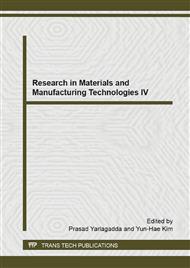[1]
E.W. Andrews and N.A. Moussa, Failure mode maps for composite sandwich panels subjected to air blast loading, Int J Impact Eng. 36 (2009) 418-425.
DOI: 10.1016/j.ijimpeng.2008.08.005
Google Scholar
[2]
Tae Seong Lim, Chang Sup Lee and Dai Gil Lee, Failure modes of foam core sandwich beams under static and impact loads, J. Compos. Mater. 38 (2004) 1639-1662.
DOI: 10.1177/0021998304044760
Google Scholar
[3]
S.V. Raj and L.J. Ghosh, Failure maps for rectangular 17-4PH stainless steel sandwiched foam panels, Mater. Sci. Eng. 474 (2008) 88-95.
DOI: 10.1016/j.msea.2007.03.102
Google Scholar
[4]
Dan Zenkert and Magnus Burman, Failure mode shifts during constant amplitude fatigue loading of GFRP/foam core sandwich beams, Int. J. Fatigue. 33 (2011) 217-222.
DOI: 10.1016/j.ijfatigue.2010.08.005
Google Scholar
[5]
S. Zhu, G.B. Chai, Damage and failure mode maps of composite sandwich panel subjected to quasi-static indentation and low velocity impact, Compos. Struct. 101 (2013) 204-214.
DOI: 10.1016/j.compstruct.2013.02.010
Google Scholar
[6]
Ji Yeong Lee, Dal-Woo Jung and Nak-Sam Choi, Fatigue fracture behavior and statistical life evaluation of hybrid composite/metal beam-joints for a low-floor bus, J. Compos. Mater. 46 (2012) 1755-1764.
DOI: 10.1177/0021998311424626
Google Scholar
[7]
M. Akil Hazizan and W. Cantwell, The low velocity impact response of foam-based sandwich structures, Composites Part B. 33 (2002) 193-204.
DOI: 10.1016/s1359-8368(02)00009-4
Google Scholar
[8]
Anderson and Todd A., An investigation of SDOF models for large mass impact on sandwich composites, Composites Part B. 36 (2005) 135-142.
DOI: 10.1016/j.compositesb.2004.05.002
Google Scholar
[9]
E.R. Fotsing, A. Ross and Edu Ruiz, Characterization of surface defects on composite sandwich materials based on deflectrometry, NDT and E Int. 62 (2014) 29-39.
DOI: 10.1016/j.ndteint.2013.11.004
Google Scholar


